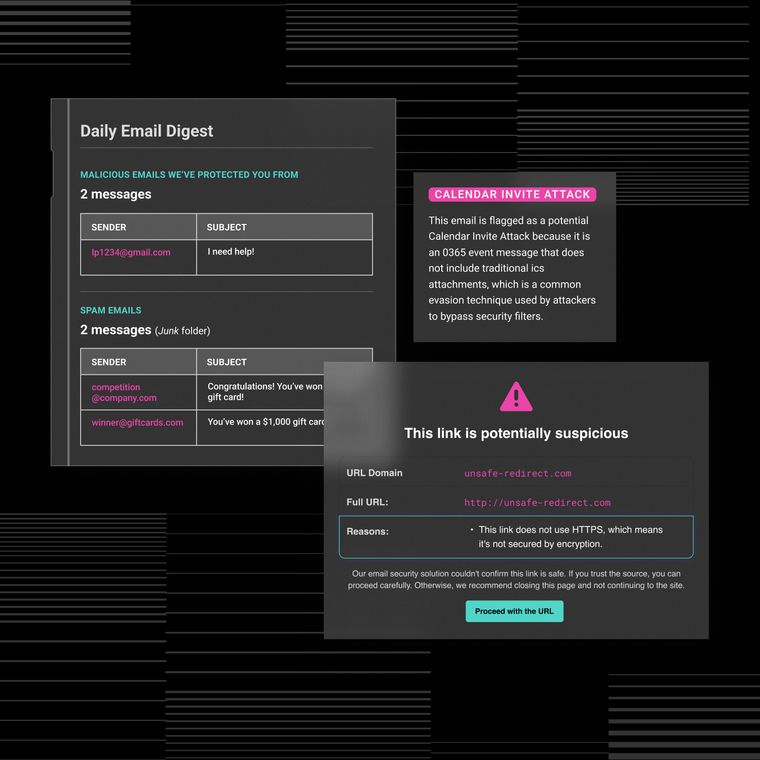Inside Pig Butchering: A Behavioral Breakdown of a Global Fraud Operation
Learn about pig butchering fraud, a new threat to organizational security. Explore operational tactics, warning signs, and strategies to safeguard your business.
April 15, 2025

Pig butchering fraud is a growing threat to organizations that combines long-term social engineering with financial deception. Unlike fast-moving phishing attacks, these scams unfold slowly, building trust over weeks or even months before striking.
What began as a consumer-focused scam has shifted toward businesses. Attackers now target employees with financial access using emotional manipulation, spoofed platforms, and fake identities to gain trust and extract funds.
This article breaks down how these scams work, the behavioral red flags to watch for, and how your security team can stay ahead of this evolving threat.
What is Pig Butchering Fraud?
Pig butchering fraud is a slow-burn social engineering scam in which attackers build fake relationships with victims before executing financial theft, often through fraudulent investment platforms.
The name comes from the Chinese phrase sha zhu pan, which refers to “fattening the pig before slaughter.”
These scams originated in Southeast Asia and initially targeted individuals, typically through romance or crypto investment cons. Today, attackers apply the same psychological tactics to businesses, focusing on employees with access to financial systems or sensitive data.
What makes pig butchering so dangerous is its patience. Unlike typical phishing, it relies on sustained trust-building and precise targeting. Common tactics include:
Researching employees and org charts using public sources
Impersonating executives, vendors, or partners
Building rapport through ongoing, friendly communication
Combining emotional manipulation with technical deception
Directing victims to fake platforms to steal money or credentials
These attacks thrive in digital-first workplaces, especially when employee roles and contact details are easy to find online.
How Pig Butchering Fraud Scams Work
Pig butchering scams use social engineering and psychological manipulation to bypass traditional defenses. These attacks evade typical security awareness training by focusing on long-term manipulation rather than urgent requests.
It Starts With a Professional Introduction
Pig butchering scams targeting organizations often begin on LinkedIn, where attackers pose as investors, consultants, or potential partners. They build credible profiles and tailor their outreach using shared connections, recent company news, or industry-specific language to make the message feel legitimate.
Their goal is to reach employees with financial authority or strategic influence. Scammers often engage in visible ways to build familiarity before making direct contact. This means you’ll see these scammers joining relevant groups, commenting on posts, and interacting with company content.
These early touches establish presence and reduce suspicion when the eventual message arrives.
Building Trust Through Grooming and Reciprocity
Once contact is made, attackers spend weeks building rapport. What begins as business talk slowly shifts into a more personal connection, backed by what feels like real value.
Scammers rely on psychological strategies designed to create familiarity and lower defenses, such as:
Sharing industry insights that appear timely and credible
Introducing “colleagues” to widen the circle of trust
Demonstrating expertise aligned with the victim’s role or sector
Offering favors or guidance to create a sense of obligation
This phase isn’t about the pitch, it’s about gaining trust. During this time, attackers gather information about internal processes, financial pressures, and who controls investment decisions.
Framing the Fraud as a Strategic Opportunity
When the attacker senses the time is right, they introduce an “exclusive” investment opportunity, often framed as a strategic business move. These offers are rarely outlandish; instead, they align with real business goals like portfolio growth or alternative investments.
To appear legitimate to organizational financial decision-makers, these schemes often feature:
Fake trading platforms with real-time data and custom branding
Investor decks, financial models, and client “testimonials”
Small initial wins to build momentum and confidence
The scam appeals to logic. That’s what makes it dangerous. The attacker positions the opportunity as low-risk and high-reward, often framing it as something competitors are already doing.
Once the target engages, whether by transferring funds or entering credentials, the attacker starts to escalate. They may request larger investments, introduce fake account dashboards to simulate returns, or suddenly disappear once they’ve extracted enough value.
In some cases, attackers use stolen credentials to move laterally within the organization, leading to further financial or reputational damage.
Who's Behind Pig Butchering Fraud
Pig butchering scams are the result of coordinated, well-funded criminal networks operating at a global scale. For enterprise security teams, understanding who’s behind these schemes is key to assessing risk and improving detection strategies.
Criminal Groups Run Scam Compounds at Scale
Many pig butchering operations are run out of large-scale scam compounds in Southeast Asia. These facilities, sometimes called “fraud factories,” are operated by transnational criminal groups and structured like call centers.
Each team plays a specific role to help the scam move along:
Building fake identities and social profiles
Researching high-value targets
Grooming victims through social and professional channels
Developing and maintaining fraudulent investment platforms
Many workers in these environments are human trafficking victims, forced to run scams under threat of violence.
Laundering Networks Power the Financial Side of the Operation
While scam compounds handle social engineering, sophisticated laundering networks move the stolen funds behind the scenes. These groups specialize in converting cash to cryptocurrency, layering transactions, and obscuring the trail across borders.
Their techniques often include:
Using crypto exchanges with weak identity verification protocols
Pooling transactions to break transaction lineage
Moving funds rapidly across wallets, blockchains, and mixing services
As Chainalysis reports, this laundering infrastructure is what allows pig butchering fraud to operate globally. It lets attackers cash out with limited traceability and almost no recovery risk.
Warning Signs to Watch For in Pig Butchering Fraud
Pig butchering fraud is a long-game attack model, but the signs are there if you know where to look. Recognizing behavioral patterns and technical red flags early gives security teams a better chance to stop fraud before damage is done.
Suspicious Behavioral and Messaging Patterns
Threat actors often use predictable communication patterns when targeting organizations. Security teams should watch for:
Unsolicited Outreach: Individuals posing as investors, consultants, or strategic partners.
Inconsistent Language: Polished messaging that includes subtle grammatical errors or formatting issues.
Urgent Timelines: Pressure to act quickly on an opportunity, such as “respond within 24 hours” or “limited access window”.
Requests For Secrecy: Attempts to bypass normal approval processes—e.g., “let’s keep this between us”.
False Familiarity: References to internal company updates designed to create a sense of insider knowledge.
Risk-Free Returns: Promises of guaranteed gains, often framed as exclusive or VIP access.
Stealth Opportunities: Pre-IPO deals paired with vague disclaimers like “under NDA” or “invite-only”.
Unverifiable Testimonials: Client endorsements shared via chat or email but not backed by credible sources.
Withdrawal Delays: Excuses tied to liquidity issues or system constraints to explain missing funds.
The FBI warns that scammers increasingly use professional language and industry-specific terminology to appear credible.
This means security teams should implement training programs that help employees identify these tactics and establish clear reporting procedures for suspicious communications.
Platform and Infrastructure Red Flags
Once attackers build enough trust, they direct targets to fraudulent investment platforms, often designed to mimic real financial services.
These platforms are polished on the surface but contain structural red flags that security teams and finance stakeholders can spot with the right checks in place:
Lack of Legitimacy: No clear ownership or regulatory details, or the use of fake credentials and logos (e.g., SEC, FCA).
Vague Investment Mechanics: Heavy use of buzzwords or generic performance charts with no explanation of strategy.
Untrustworthy Domains: Recently registered websites, especially those lacking HTTPS or using anonymous hosting.
No Third-Party Validation: Absence of credible news coverage, analyst reviews, or verifiable client testimonials.
Limited Support Access: Anonymized or in-platform-only messaging channels with no external contact options.
Inconsistent Terms: Hidden fees or shifting conditions that appear after initial engagement.
Many of these platforms are built to appear legitimate while actively discouraging scrutiny. Attackers leverage technical complexity and rapid fund movement to reduce the likelihood of intervention.
To mitigate exposure, organizations should implement:
Domain intelligence and hosting analysis as part of vendor or investment reviews
Verification of principals and regulatory standing
Behavioral analytics to identify unusual access to financial platforms from employees in high-risk roles
How to Protect Your Organization and Employees from Pig Butchering Fraud
Protecting against pig butchering fraud requires a multi-layered strategy that combines policy controls, behavioral detection, and employee education.
Apply Policy and Process Controls That Reduce Risk
To strengthen your organization’s resilience against pig butchering fraud, implement the following measures:
Establish Strict Financial Approval Processes: Require multiple approvers for wire transfers and investment activities, particularly for new recipients or large amounts.
Implement Vendor And Investment Verification Procedures: Create formal workflows for validating new platforms and partners before engaging financially.
Develop Clear Due Diligence Protocols: Outline the exact steps employees must follow before committing company funds to external investment opportunities.
Create Secure Communication Channels: Use official, authenticated platforms for all financial communications to reduce the risk of impersonation.
Deliver Targeted Security Awareness Training: Focus specifically on social engineering tactics used in pig butchering scams, including long-term grooming and fake investment pitches.
Deploy Technical Controls For Early Detection: Implement advanced email security to monitor for unusual sender behavior, suspicious language, and links to fake financial sites.
Use Behavioral AI to Identify Social Engineering
Traditional security tools like email filters struggle with relationship-based attacks because they rely on known threat indicators. In contrast, behavioral security technologies shine against pig butchering fraud because they spot abnormal patterns that traditional security tools miss.
These solutions analyze communication behaviors and flag suspicious activities by:
Detecting deviations in normal communication behavior
Flagging new senders attempting to build trust
Surfacing messages with investment-related language
Identifying fake urgency and high-return promises
Blocking socially engineered emails before delivery
These capabilities give security teams early visibility into relationship-driven threats before employees are persuaded to act.
Establish Reporting and Response Protocols
If your organization detects or experiences a pig butchering attempt, respond quickly and methodically:
Report to law enforcement via your local FBI office or the Internet Crime Complaint Center (IC3).
Notify financial institutions involved to attempt to freeze or reverse transactions.
Preserve all communications with the scammer as evidence.
Inform regulators if required (e.g., SEC, FINRA, state agencies).
Analyze the incident to identify control gaps and improve safeguards.
Support affected employees, including mental health and counseling resources if needed.
Building a response playbook for social engineering ensures your team can act fast—and confidently—when it matters most.
Staying Ahead of Modern Fraud
Pig butchering fraud is evolving fast, so your defenses need to adapt. These scams rely on patience, psychology, and precise targeting, which makes them hard to catch with traditional tools alone.
Security leaders need layered protection that pairs employee awareness with adaptive behavioral detection. That means:
Building a culture where employees can spot long-game scams
Using AI to surface subtle behavioral anomalies
Establishing fast, reliable reporting paths across the organization
Abnormal’s behavioral AI platform detects the trust-building signals behind pig butchering fraud before attackers can act. By analyzing communication patterns and flagging risky behavior in real time, Abnormal helps security teams protect people—not just infrastructure.
Schedule a demo today to see how Abnormal identifies and stops the social engineering tactics that others miss.
Related Posts
Get the Latest Email Security Insights
Subscribe to our newsletter to receive updates on the latest attacks and new trends in the email threat landscape.


